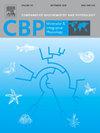盐度胁迫下草鱼的生存及急性渗透调节反应。
IF 2.2
3区 生物学
Q4 BIOCHEMISTRY & MOLECULAR BIOLOGY
Comparative Biochemistry and Physiology A-Molecular & Integrative Physiology
Pub Date : 2025-07-11
DOI:10.1016/j.cbpa.2025.111905
引用次数: 0
摘要
广泛分布于全球的内陆咸水由于渗透压高,对水产养殖造成了严格的限制,使大多数水生生物无法生存。草鱼(Ctenopharyngodon idella)是世界上养殖最广泛的淡水鱼,它仅局限于淡水栖息地。该物种适应咸水养殖具有显著的生态和经济潜力;然而,其在高盐环境中渗透调节的机制仍然知之甚少。本研究选取平均体重为15.42 ± 0.96 g的草鱼幼鱼,在0、4、7、10、13和16 ppt 6个梯度下进行了急性耐盐性试验。首先测定96 h中位致死盐度浓度(LC50),然后通过生理生化分析评估渗透调节动力学,并对急性应激条件下盐度响应基因表达进行靶向量化。结果显示死亡率呈盐度依赖性上升,LC50-96 h为10.58 ppt。在24 h(0、4、7和10 ppt)盐度下,草鱼血清电解质(Na+、Cl-、K+)和皮质醇(P +/K+- atp酶(NKA)活性在10 ppt时显著升高(P +/K+- atp酶(NKA)活性)呈盐依赖性升高本文章由计算机程序翻译,如有差异,请以英文原文为准。

Survival and acute osmoregulatory response of grass carp under salinity stress
Inland saline waters, widely distributed globally, impose stringent constraints on aquaculture owing to their high osmotic pressure, preventing most aquatic organisms from surviving. As the most extensively farmed freshwater fish worldwide, the grass carp (Ctenopharyngodon idella) is confined to freshwater habitats. The adaptation of this species to saline aquaculture holds significant ecological and economic potential; however, the mechanisms underlying its osmotic regulation in hypersaline environments remain poorly understood. In this study, juvenile grass carp with a mean body weight of 15.42 ± 0.96 g were subjected to acute salinity tolerance tests across six gradients (0, 4, 7, 10, 13, and 16 ppt). The 96 h median lethal salinity concentration (LC50) was first determined, followed by the evaluation of osmoregulatory dynamics through physiological-biochemical profiling and targeted quantification of salinity-responsive gene expression under acute stress conditions. Results showed mortality exhibited salinity-dependent escalation, and the LC50–96 h was 10.58 ppt. Under 24 h salinity exposure (0, 4, 7, and 10 ppt), grass carp exhibited salinity-dependent increases in serum electrolytes (Na+, Cl−, K+) and cortisol (P < 0.05). Serum osmolality remained stable at 4 ppt and 7 ppt but increased significantly at 10 ppt. Serum prolactin showed progressive decline from 7 ppt. Superoxide dismutase (SOD) and glutathione peroxidase (GSH-Px) activities in the liver, kidney, and gills showed salinity-stimulated upregulation (significant at 7 and 10 ppt). Immune-related enzymes, acid phosphatase (ACP) and alkaline phosphatase (AKP), increased at 4 and 7 ppt, whereas AKP activity declined at 10 ppt. Gill Na+/K+-ATPase (NKA) activity was significantly elevated at 10 ppt (P < 0.01). Moreover, both gill and kidney structures exhibited significant alterations under 7 ppt and 10 ppt salinity stress. Specifically, the gill showed cracks in the filaments, chloride cell hyperplasia, and detachment of flattened epithelial cells; renal tubules were atrophic. The expression of ion transport-related genes NKA and solute carrier family 12 member 2 (SLC12A2) in the gills increased with increasing salinity; both genes showed significant differences at 7 ppt and 10 ppt, indicating their role in regulating osmotic pressure balance. This study provides a theoretical basis for the saline aquaculture technology and salt-tolerant variety development in grass carp.
求助全文
通过发布文献求助,成功后即可免费获取论文全文。
去求助
来源期刊
CiteScore
5.00
自引率
4.30%
发文量
155
审稿时长
3 months
期刊介绍:
Part A: Molecular & Integrative Physiology of Comparative Biochemistry and Physiology. This journal covers molecular, cellular, integrative, and ecological physiology. Topics include bioenergetics, circulation, development, excretion, ion regulation, endocrinology, neurobiology, nutrition, respiration, and thermal biology. Study on regulatory mechanisms at any level of organization such as signal transduction and cellular interaction and control of behavior are also published.

 求助内容:
求助内容: 应助结果提醒方式:
应助结果提醒方式:


